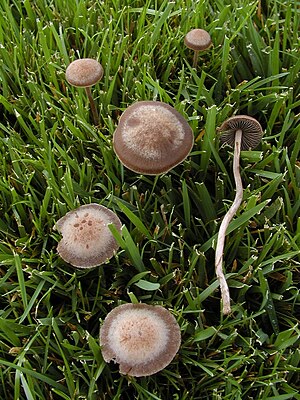Hay manure
| Hay manure | ||||||||||||
|---|---|---|---|---|---|---|---|---|---|---|---|---|

Hay manure ( Panaeolina foenisecii ) |
||||||||||||
| Systematics | ||||||||||||
|
||||||||||||
| Scientific name | ||||||||||||
| Panaeolina foenisecii | ||||||||||||
| ( Pers .: Fr. ) Maire |
The hay manure mushroom or hay cuttings ( Panaeolina foenisecii , syn. Panaeolus foenisecii ) is a type of fungus from the family of the Mürbling relatives (Psathyrellaceae) and belongs to the genus Panaeolina , which differs from the genus of the "real" manure-like spores ( Panaeolus ) by warty. In English, the species is referred to as "Haymakers toadstool".
features
Macroscopic features
The delicate fruiting bodies appear gregarious to grassy. The stem is pale brown in color, somewhat frosted, has a silky sheen and reaches a length of 40–80 mm and is about 2–3 mm thick, the base of the stem is narrow. On the stem sits the half-bell-shaped hat, which has a diameter of 10–30 mm and is dark brown, clay-colored when dry, its rim is dark. The slats are removed. They are brown when young and have a white-blotchy edge; when they grow older, the fruiting bodies are black-brown and spotted. The flesh is brownish in color.
Microscopic features
The almond-shaped spores of the hay manure are light brown and 13-15 µm long. Their surface is rough and warty.
Ecology and phenology
The hay manure populates grasslands and pastures of all kinds, but above all agricultural areas. It lives saprobion table on rotting grass and is therefore often found on freshly mown lawn. It can also be found on the edges of forests and roads and on the dung of many larger herbivores, especially horses and cattle.
From summer to autumn, the hay manure appears primarily shortly after a mowing , which is why it is also called "hay cuttings".
distribution
The distribution area of the hay manure extends over the temperate zones of Europe , North and South America , Asia , North Africa and Australia . It's relatively common.
meaning
The hay manure is a slightly poisonous mushroom and, when eaten raw, generally leads to digestive disorders. Like all fertilizers, it produces 5-substituted indole compounds such as serotonin , but these are ineffective when taken orally. While the psychoactive substance psilocybin could be detected in some areas in the USA and Canada , it could not be found in the mushroom elsewhere, accordingly the cause of the psilocybin syndrome , as it is also caused by other fertilizers, is highly controversial. It has been shown to have hallucinogenic effects in some cases . Cases of poisoning are documented from Great Britain .
swell
literature
- Volkbert Kell: Poison mushrooms - mushroom poisons , Ziemsen Verlag, ISBN 978-3-89432-305-9 .
- A. Gminder and T. Böhning: Which mushroom is that? , Franckh-Kosmos-Verlags-GmbH and Co. KG, ISBN 3-440-10797-3
- Andreas Alberts, Peter Mullen: Psychoactive plants, fungi and animals. Kosmos-Verlag, Stuttgart 2006, ISBN 3-440-10749-3
- Josef Breitenbach, Fred Kränzlin (Ed.): Mushrooms of Switzerland. Contribution to knowledge of the fungal flora in Switzerland. Volume 4: Agarics. Part 2: Entolomataceae, Pluteaceae, Amanitaceae, Agaricaceae, Coprinaceae, Bolbitiaceae, Strophariaceae. Mykologia, Luzern 1995, ISBN 3-85604-040-4 .
Individual evidence
- ↑ Michael Jütte: Discovering Biology Today SI . tape 2 . Schroedel-Verlag, 2004, ISBN 3-507-86104-6 .